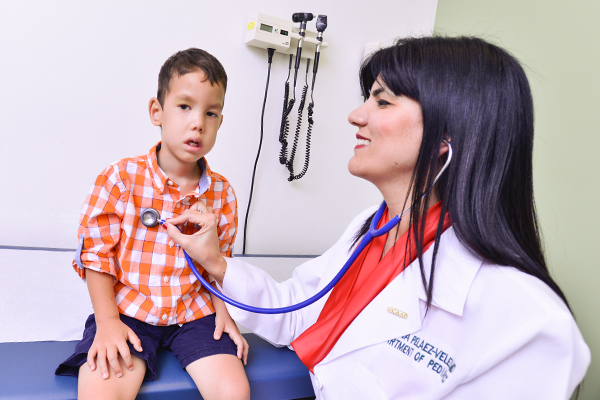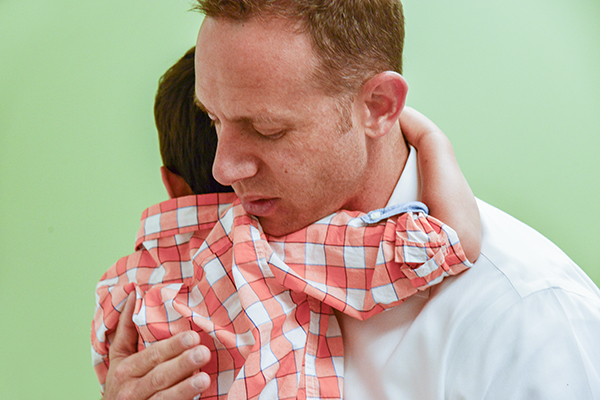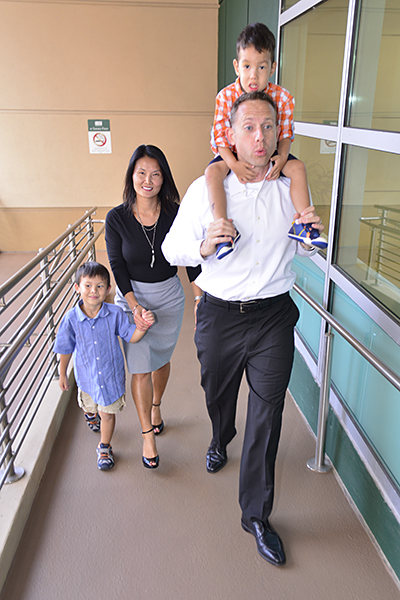
The Lane family visits USF Health Pediatrician Dr. Cristina Pelaez (left) for a check up, and a flu shot.
It is unlikely that Tim and Angel Lane will ever move from Tampa. At least, not in the next couple of decades.
Their proximity to a network of experts who care for their son Jameson is too important to risk trying to find something similar elsewhere.
Jameson has a genetic form of hypotonia, meaning he has muscle weakness throughout most of his body. Both he and his twin brother Walker were born with hypotonia, turning their expected healthy birth – albeit an early one – into a dire emergency. Having little to no muscle control at birth meant the babies could not breathe on their own or suck or swallow.
“There was a great deal of stress from the get-go,” Tim said, recalling the intensity of everyone in the delivery room. “Neither boy could suck or swallow. Neither could blink.”
“We were all on pins and needles, even the doctors,” Angel said.
***
The Lanes’ first experience with the Doctors of USF Health was when their twin boys were transferred to the Muma Neonatal Intensive Care Unit (NICU) at Tampa General Hospital when they were 3 months old. They were in need of more advanced care and it was in the Muma NICU that the Lanes met a team of experts from the USF Health Morsani College of Medicine.
USF maternal-fetal medicine specialists, neonatologists, pediatric surgeons, pediatric radiologists, pediatric cardiologists, pediatric neurologists, geneticists, and many other health care specialists surrounded the twin boys over the many months they stayed in the NICU, followed the boys as they progressed to the pediatric intensive care unit, and there the many times the Lanes brought them to TGH’s emergency room. Even for ongoing visits, it’s a team of USF Health pediatricians who check progress and address issues.
By connecting with USF Health, the Lanes found an integrated team of experts within one group, providing seamless care to Jameson and Walker. But what the Lanes also found was a medical home – a patient-centered approach to delivering primary care that allows families to rely on only one group of health care providers.
“USF’s medical home concept made caring for our boys so much better,” Tim said. “There is an entire team of professionals here who knew the nuances of their condition. We have to be advocates for our children, who needed very specialized care. And to do that, we need help from top experts in uncommon conditions, as well as an integrated approach. That level of coordinated care means Jameson’s history is known by everyone on the team.”
“We were new parents, so to have doctors and nurses already aware of our entire story made every visit so much more seamless,” Angel said. “Without that transition from NICU to USF Health, I don’t know how successful we would have been in caring for our boys.”
“Our goal with acting as a medical home for patients really starts with the needs of the patients and their families,” said Cristina Pelaez, MD, assistant professor of pediatrics and director of the Medical Home Program for USF Health Pediatrics. “Medical homes provide families with a support system of experts who work with each other and talk with each other. In a broader sense, a medical home can also reduce medical costs in the long term, help children have better access to health care and improve health care use patterns, thus preventing disease for these children.”
***
Many different diseases and disorders cause the symptoms of hypotonia. But diagnosing the disease or disorder causing the problem can be challenging. It could be one of as many as 500 different conditions, Dr. Pelaez said.
For the Lanes, not knowing the underlying problem meant they had to take it day by day, with round-the-clock monitoring of their breathing and oxygen intake and feeding them through a feeding tube.
“They were amazing and prepared us before we took the boys home,” Tim said. “When we were discharged from the NICU, went home with a full entourage. That’s the scariest thing you face, is leaving. Before discharge came along they started working with us, showing how to use the pulse ox (pulse oximetry, used for monitoring oxygen saturation) and how to suction to clear their airways. We needed to suction the boys 30 to 40 times a day.”
But even with that level of attention, Walker succumbed to pneumonia from influenza and died in February 2013, just shy of his second birthday. The Lanes, still unaware of the root cause of the hypotonia, weren’t sure what the future held for Jameson.
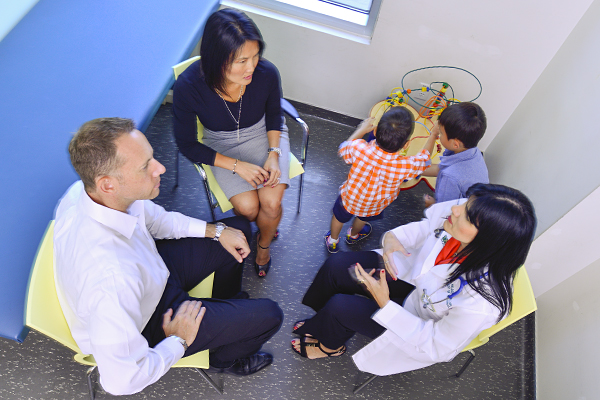
Tim and Angel Lane hear details of on-going care from Dr. Cristina Pelaez, as Jameson and his older brother Braden play.
For two years, Jameson remained undiagnosed while doctors took blood samples and biopsies to conduct tests that ruled out the many possibilities of underlying conditions, including cerebral palsy, muscular dystrophy, among others.
It took a specially trained metabolic geneticist to finally determine Jameson’s root problem. Amarilis Sanchez-Valle, MD, is assistant professor of pediatrics in the USF Health Morsani College of Medicine and the only board-certified medical biochemical geneticist in the region.
What Dr. Sanchez-Valle found for the Lanes was that Jameson has nemaline myopathy, a congenital, hereditary neuromuscular disorder. Children born with nemaline myopathy often gain strength as they grow, and those with mild forms eventually walk independently, although often at a later age than their peers.
The firm diagnosis for the Lanes means they will worry a bit less — nemaline myopathy is not progressive so Jameson’s condition will not worsen – and are in a better position to help their son grow.
***
Jameson is walking. He’s even running around and playing, chasing his older brother Braden. Physical and occupational therapy are helping him learn to swallow and helping with his speech. Individuals with NM are usually highly sociable and intelligent, so on-going therapy will help him thrive.
“Jameson continues to flourish,” Tim said. “He would not be without help from TGH, and USF, and Dr. Pelaez. She really took our boys under wing. We did not want for anything. Here, we are listened to, we are heard, and get to weigh in on decisions. The team put us in the best possible position for success.”
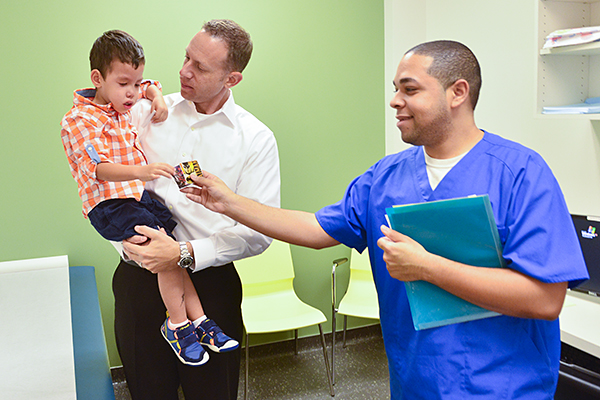
And then, tearfully, accepts his well-earned sticker from pediatric nurse Rafael Uribe
The Jennifer Leigh Muma Neonatal Intensive Care Unit
Thousands of babies who are born too early benefit from the generosity of Pam and Les Muma. In 2009, the Mumas provided $6 million to USF Health to establish a highly specialized neonatal intensive care unit in the heart of Tampa General Hospital’s Children’s Medical Center. Their gift, one of the largest in Florida to support research and care for newborns, resulted in $14 million with eligible state and internal USF matches.
Named after their daughter who died in a neonatal nursery, the Jennifer Leigh Muma Neonatal Intensive Care Unit (NICU) was created to provide leading-edge treatment, training and research. With more than 50,000 square feet, the entire space is designed with a baby’s family in mind, from the colors of the corridor walls to the placement of telephones in each patient room. The NICU features 80 single-family rooms, a procedure room, and a semi-private area for 12 transitional babies. Light switches are placed strategically and bulbs angled to ensure the babies will not be startled by unintended bright light in the softly lit atmosphere. Even the hallways keep babies in mind with acoustic ceiling tiles that absorb excess noise.
Teaching and research are also key components of the NICU mission and environment, transforming patient care here, as well as advancing the study of neonatology in medical and academic institutions around the world. Neonatology fellows, pediatric residents and nurse practitioner students learn together, with a majority of teaching taking place bedside, patient to patient. The partnership between TGH and USF is the key to those efforts.
Story by Sarah A. Worth, photos by Eric Younghans, USF Health Office of Communications
